
Spring doesn’t officially start for another week, but it already feels like it’s here. The songbirds are singing; the dandelions blooming. It’s time for lazy afternoons lounging on the porch while basking in the warm glow of the sun, and bike rides through the city to get some cold ice cream.
Presumably, anyway. I spent this sunny weekend indoors, doing my taxes and packing away winter clothes. Heavy sport coats and outerwear are easy. Just send them off to a reliable dry cleaner, then zip them up in breathable garment bags before storing them away. Knitwear, on the other hand, is another matter.
If you’re a responsible person, your knitwear is probably clean, tidy, and ready to be packed. If you’re anything like me, however, you have a pile of dirty sweaters sitting somewhere (probably a bedroom armchair). So here’s a full guide, with links to previous Put This On articles, on how to take care of your knitwear – to be used throughout the winter like a normal person, or in the middle of March when you’ve put things off until the last minute.

Cleaning Your Knitwear
Sweaters don’t have to be washed after every wear, but they do have to be cleaned at some point. Especially before you pack them away, as microscopic bits of food can otherwise attract moths and silverfish.
Tougher cotton knits can be thrown into the laundry machine, but anything made from finer fabrics will have be washed by hand. We have a full, step-by-step guide here, if you need.
The basics are simple: You want to fill up a sink basin with water and a bit of gentle detergent. We recommend Woolite Dark or Soak, the second of which is a no-rinse detergent that allows you to skip the rinsing process (much appreciated when you have a pile of knits to go through). Then just submerge your sweater and gently swish it around.
There are two things here you’ll want to avoid. First, never let an open stream of water hit your sweater, as you can felt the fabric. Second, never wring out a wet sweater (yarns are delicate when wet). Instead, when it’s time to dry your sweater, you’ll want to gather it into a ball and squeeze out as much water as you can. Then roll it up in a dry towel to get any excess. For the final step, lay it out somewhere to dry. Sweater racks are fancy, as they help air circulate from below, although you can also just set your knit somewhere on a new towel.
Fixing Holes and Snags
Even the most careful of us will get holes and snags in our knitwear at some point. We have a guide here on how to fix snags, which includes links on how to carefully reset the yarns. Realistically, the best way is to just use something like Snag Nab-It – a simple tool that allows you to pull a snag to the other side of a sweater, where it’ll never be seen.
The simplest way to fix a hole is to send your sweater to a professional. I’ve gotten good results from The French American Reweaving Company in NYC, although lots of people also recommend Best Weaving & Mending. Both places specialize in what’s called invisible darning, which is where a skilled re-weaver fills in a hole with new and matching material (the technique works on finer suit fabrics, by the way). A simple repair job for knitwear will run you about $50. If that’s too expensive, we have a full guide here on how you can fix a hole at home.

Getting Rid of Pills
Nothing makes a sweater look worse than pilling. Those are the fuzzy, little balls you get around areas of high-friction. Higher-end sweaters are less likely to pill because they’re made from yarns with longer fibers, but with enough wear, everything pills eventually.
Luckily, you don’t have to live with pills. And with some quick brushing up, your old knits can look as good as the day you brought them home.
We recommend getting rid of pills with a sweater shaver. They’re better than sweater stones and combs because, unlike those solutions, they don’t damage the yarns. Remember, pilling happens when the fibers break and tangle into each other. Sweater stones and combs will get rid of pills, but they also create new, microscopic breakages that cause more pilling later. A sweater shaver, on the other hand, cleanly cuts things off.
The key here is to get a good sweater shaver, as cheap, generic ones often have dull blades. Mine, pictured above, is unfortunately no longer sold, but you can find plenty of good options on Amazon. Look for something with good reviews and runs at least $15 or more.
Packing Them Away
Finally, after all the cleaning, fixing, and de-pilling, it’s time to pack things away. As always, you want to store knitwear neatly folded and flat. Never hang knitwear, as you can stretch out the garment.
For winter storage, I like to use linen boxes, as they allow air to circulate (just throw in some cedar sachets to ward off moths). The Container Store also has plastic bins and Allen Edmonds sells handsome, cedar containers. Graham Woodworking offers handmade cedar chests, if you have a lot of knitwear and want to save closet space.
If you’re stacking your knitwear on top of each other, take care to put the heavier knits on the bottom, so thinner knits don’t get squished. It might also be good to vacuum your storage spaces (let’s be honest, you haven’t been vacuuming either). You never know if moth eggs and larvae are hiding in those nooks and crannies.
With proper care and storage, your favorite knits will be ready for you next fall, looking as good as you left them.








